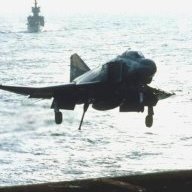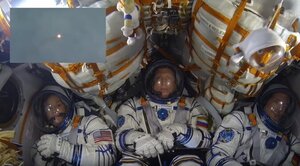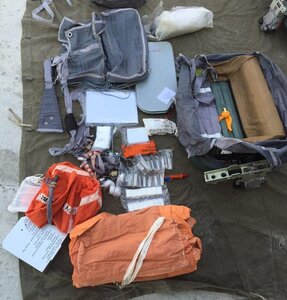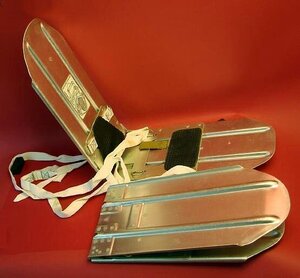-
Posts
7,516 -
Joined
-
Last visited
-
Days Won
133
Content Type
Profiles
Forums
Gallery
Downloads
Blogs
Events
Our Shop
Movies
Posts posted by willedoo
-
-
I'm still trying to get my head around the picture of cosmonauts equipped with guns and snow skis!!!!!!
Where did they find room for all that in those tiny space capsules?
Here's a screen grab of the inside of a Soyuz crew capsule during a launch. Apparently the large white bulk with the orange straps behind the Astro/Cosmonauts contains the parachutes and is also where the survival gear is stowed. It looks a bit cramped; they have to sit in a foetal position to fit in. The wide angle lens makes it look a lot bigger than what it is.
[ATTACH]50595._xfImport[/ATTACH]
At a guess, I'd say the survival kits would be no bigger or more elaborate than the aircraft ejection seat kits on a per person basis. The basic brief is gear to survive two to three days in the wild. The Sukhoi and MiG seat kits are quite compact and fit in the seat base along with a one man dinghy. They seem to achieve that by everything being small and minimal. The first aid kit for example is basically a bandage or two, some iodine and morphine doses. No scissors, eyewash or any of that stuff, just something to stop bleeding and pain and some iodine as a disinfectant. The Russians have a few different kits depending on use, but most share the core items of communication, signalling, first aid, food and water stock, camp equipment and weaponry.
They differ in whether arctic (snow shoes and less water) or desert (more water). One kit doesn't have a dinghy in the non marine version and has extra desalinator kits in the marine version. One combat kit is a standard kit with an extra compartment to hold an AKS-74U automatic rifle. It's the short one with almost no barrel and a folding stock, although in Afghanistan, most aircrew chose to carry them at the ready in the cockpit. There was a large side holster designed so they could wear them on their hip or some just slung them over the shoulder.
The photo below is taken at the Russian airbase in Syria and shows a NAZ-7M, which is the smallest, most compact kit. The object at centre right is the seat base (upside down) and shows where the dinghy and survival pack is stowed. The dull orange object in the foreground is the one man dinghy and everything above that stows in the grey polyester case at the top of the photo. After ejection and upon seat separation, static lines pull pins to release the survival pack and floating radio kit followed by the dinghy.
Nearly everything works automatically. CO2 devices inflate the dinghy and radio kit in the air and the radio turns itself on. All the pilot has to do is release his chute just on touchdown, then using the lanyard, pull the dinghy to him. Then he climbs in and continues pulling in the lanyard which has the survival pack and radio at the end of it. Plug the radio into the helmet comms and Bob's your uncle. The radio has three modes - emergency beacon emitter which is the default mode when it turns itself on, long range radio frequency to contact base, and short range two way to converse with the rescue crew.
[ATTACH]50596._xfImport[/ATTACH]
-
 1
1
-
-
-
That device looks a lot like a cat carrier to me.
Or some 19th. Century medical device.
-
Based on our recent bushfire experience, we can see that the Japanese could have been defeated by tossing a few Red Heads around.
We'd only need one Red Head and that's Pauline. She would have scared the lot of them back to Japan.
-
There's a bunch of idiots in the crowd at the ATP tennis in Sydney blowing klaxon horns. It makes it very unpleasant viewing. Surely the authorities will nip that in the bud before long.
-
I'm still trying to get my head around the picture of cosmonauts equipped with guns and snow skis!!!!!!
Where did they find room for all that in those tiny space capsules?
Pete, they call them skis but in reality they are just snow shoes. Made of duralumin, they fold in half and fit in a seat width pack. A fairly crude set of straps tie them to your feet. I've got a pair somewhere but this photo is one off the net of the same thing.
[ATTACH]50589._xfImport[/ATTACH]
-
All of this fascinates me too. I have spent decades thinking about cutting and breaking rock efficiently. Can’t help thinking the ancients knew something that I don’t.
I remember seeing this video a long time ago, as is evident by the film quality. This bloke had some good techniques for moving big things.
-
Sandra Bullock landed in a lake in a wilderness, with nobody to help her. Hope she had a few Girl Scout skills.
If I was a lonely woodsman, I'd look after her. She could share my camp oven any day.
-
Last night I watched Gagarin, an excellent movie about the first man in space. Much better than American movies.
Poor old Yuri just missed ending up in the drink, and landed in a ploughed field. The farmers were frightened of this strange man from space and ran away from him.
(Might still be available in SBS on Demand.)
I haven't seen that movie yet; must do it one day. I've seen another much earlier Russian documentary on it; I think it's on Youtube somewhere. It was post Soviet and I was surprised how frank it was.
In regards to the earlier reference to the survival gun, I did some checking and it was introduced after some pushing by first space walk cosmonaut Aleksey Leonov. He ended up fairly high up in the cosmonaut training programme and they say he never forgot the time they spent in the forest when their re-entry went wrong after the first space walk. They ended up about 600k off mark in the wilderness around the Urals. Apparently all they had was one 9mm Makarov between them; not much use against a bear. Leonov and his mate had choppers scaring wolves away but they couldn't land. Eventually the cosmonauts used their snow skis to hike out to a chopper.
The future survival firearm he pushed for is more shotgun than pistol. An under and over design with two short 28g shotgun barrels on top, break action, with one rifle barrel underneath. I think the signal flares were fired through the smooth bore shotgun barrels. The machete attached to double as a shoulder stock. The rifle calibre was basically a 5mm AK-74 round modified with soft hollow points. They were issued with 11 rifle rounds (I'd say for bears), 10 bird shot and 10 signal flares. The bird shot would be the best deterrent for a pack of wolves I would think. Yuri was a lot luckier coming down in a settled area.
-
Willie, that's so strange it must be true!
The firearm referred to above is a combination shotgun, rifle & flare gun plus machete. I just did a bit of checking and some sources say it was removed from the survival kit in 2007 to be replaced by a standard semi-automatic pistol. Some other sources say a firearm is still on the survival kit contents list but hasn't been taken up in space for a few years now. Roscosmos, the Russian space agency now say that they are testing a new version to be reintroduced in the next year or so. Not sure if the non Russian ISS crew would be too keen on the idea though.
I've never seen the contents of the Soyuz survival kits, but I'd assume they would have a fair bit in common with the fighter ejection seat kits. The MiG and Sukhoi seat kits have quite a few variants to suit area of operations - desert, arctic, over water or not, and a lot of the contents overlap.
-
Just a bit of trivia on the subject, some people might not be aware that the Russian cosmonauts are the only people in space to have firearms. They are part of the survival kit and I'd assume they would be permanently stowed in the Soyuz crew capsule. Designed for survival in the Taiga for a couple of days if the landing doesn't go to plan. Quite a beast of a thing they are compared to the pistols the fighter pilots carry.
It would be highly unlikely these days that a landing would be so far off course, but I think it's happened in the earlier days, hence the fairly elaborate kits.
-
Octave - Page 9 of the report has total world consumption at the bottom by type of energy. It rolls renewables into one item. To split out the renewables you need the table on page 52 which is expressed in terrawatt-hours. So you can proportion that out against the renewables item, from page 9.
pm, I have to hand it to you - in the face of much adversity on this thread, you give it a good shot. Like a boxer on the ropes.
-
I have also noted an image, purported to be a NASA satellite photo of our continent. It shows fires generally scattered including in central desert areas and far north Queensland.
Fake news is everywhere.
I wonder if the satellites are picking up the controlled spinifex burns in central Australia. A lot of the aboriginal people still burn in the summer months.
-
Is survival without ice cream really worth it?We should start a thread on what we can and can't live without; what you would pack in your quick-escape bag.
People often laugh at how many bottles of water I carry in my car.
For a starter, there's a lot of cheap Chinese survival knicknacks on eBay, but I wouldn't trust those little Chinese compasses. I've got a couple that are about 40 degrees out of whack.
-
This lady from News Corp has told Rupert to stick his job up his clacker.
-
I guess it's all relative to history. The day will come when the Earth has moved close enough to the sun to become a dead, lifeless planet. Humans are just a blip in time.
-
I think the ISS has been a good thing for the world. It brings countries together for a common scientific goal and mostly without politics. Introducing politics to space research and everyone having separate stations seems to be a backward step.
I can understand American pride driving them to be a space player without relying so heavily on the Russians, but it's easier and cheaper if they all cooperate.
-
It looks like Scotty is gaining international fame:
-
It will be interesting to see what happens to the ISS in the near future. Funding to 2024 might work in with the start of the Chinese space station where the Europeans are going. I doubt Russia could afford to build one of their own, so maybe there's a possibility of them joining the Chinese station. Considering that China and America refuse to cooperate in the new Chinese station, it might leave the US out in the cold.
-
I once helped someone on the dirt road between Ivanhoe and Darnick. He had a flat tyre and the little Holden spanner wouldn't undo the nuts. Mid day, mid summer and he was carrying no water. Was quite stressed.
You could be in real trouble if there's no shade trees in that situation. I remember once waiting with a mate on the Birdsville track for someone. It was January, around 50 degrees+ with no trees, on that Sturt's Stony Desert section. Very few locals travel that time of year and we were there for a few hours and saw no cars go by. If you had no water, you might not make it through the day in those conditions. Even laying under the Toyota wouldn't have helped as the stony, gravelly ground was so hot. Only option was to sit in the Toyota with the doors open. We had plenty of water, but it got me thinking how quickly someone could be in trouble without it.
-
Wind power globally produces less than 0.5% of our energy and is unlikely to become significant.
Where does that figure come from?
"As at July 2018, wind power supplied around 33.5% of Australia's renewable electricity or 7.1% of Australia's total electricity, was sourced from wind power.[3
https://en.wikipedia.org/wiki/Renewable_energy_in_Australia#Wind_power
One of you is quoting a global figure and the other is quoting a link in reference to the Australian percentage. You're not quite on the same page. Regardless, according to the Australian Renewable Energy Agency, the amount of power provided by wind globally is almost six percent.
-
There's a lot of little things you can do. In the 80's we had water type stored pressure fire extinguishers. I always made a point of filling them with drinking water only, no salty water or detergent/dispersants. From memory they hold 9 litres, about two days worth of water. It paid off as I had to drink mine just north of Lake Eyre. It tastes a bit stale and musty, but it's fresh and kept me going until we got through to an area with drinkable water.
Not sure how well it works, but an old bloke once told me how to interpret cattle tracks to determine if they are heading to or from water. I can't remember which way around it was, but his theory was that cattle will walk around a small log or branch going one direction and step over it going the other way.
-
Reading the Iranian news this morning, it looks like the propaganda machine is in full swing. The commander of the IRGC Aerospace Division is claiming they knocked out the air base command centre and their EW forces jammed all the American drones after the attack. He's also saying that there were wounded taken to the US hospital in Baghdad. You would think if that was the case, it would be easy to verify. More likely just a few empty hangars hit, but who knows.
There's no doubt the Iranians have advanced EW capabilities as they were able to hack and land the CIA's RQ-170 Sentinel stealth drone in 2011 and reverse engineer it. So the drone jamming part of the General's statement could be true.
-
We should start a thread on what we can and can't live without; what you would pack in your quick-escape bag.
People often laugh at how many bottles of water I carry in my car.
Reminds me of a surveyor I once worked with. He'd made a hobby of bush survival, learning all about bush tucker and survival skills. He had a little Suzuki 4WD with water and food squirreled away everywhere, inside the door linings and body trim. Every little nook and cranny held something. He even had a complete oil change in oil stored inside his bullbar.






Survival
in General Discussion
Posted
I've had a fair bit to do with these kits but know almost nothing of Western survival kits. I get the idea that the Russian kits are a bit more comprehensive, most likely to do with the vast expanses of wild country they have east of the Urals. It would be interesting to see what the Americans have in their kits flying out of Alaskan bases. They would have the same issues with cold, remoteness, bears and wolves etc.. I'd assume they'd have a lot more gear than those flying in areas like California and Nevada.
It's an interesting evolution. The MiG-15 from late 1948/1949 onward was the first Russian production aircraft with an ejection seat, and the first survival kit was introduced in 1958, so there was nearly a ten year period where the pilots had very little emergency equipment after ejection. It was probably a similar timeline in the West.